Nationwide Nasdaq-100® Risk-Managed Income ETF (NYSEARCA:NUSI) is a highly popular covered call fund. The fund is known for applying a collar approach which combines covered call writing with buying of protective puts as an insurance policy. In my last article titled NUSI’s Approach Simply Doesn’t Work written earlier this year I was not particularly bullish on this fund but the fund has done very well this year, so what gives? It turns out that the fund actually shifted its strategy in a significant way and doesn’t do collars as regularly anymore so its performance improved as a result of this. As a result, the fund is now up almost 25% year to date in total returns.
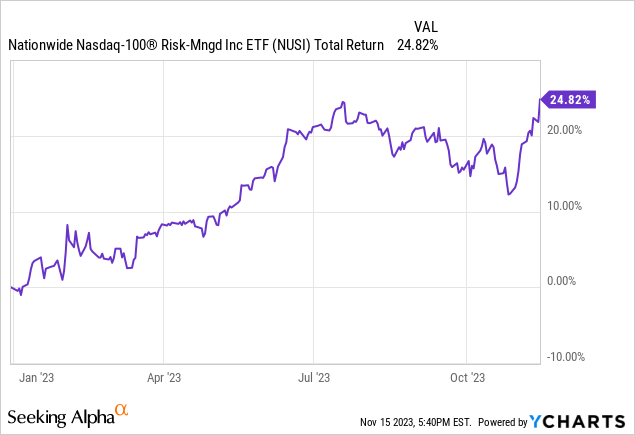
Before I get back to NUSI, let me explain why I’m not a huge fan of collars. Below is a graphic that shows how a collar strategy typically works. You buy 100 shares of a stock or ETF, you write a call option slightly out of money and you buy a put option also slightly out of money, with both options having same expiration dates. The idea is that you will collect more from your covered call premium than you’ll spend on your protective put and keep the difference as a profit as well as a small upside. Let’s say you have a stock that’s exactly $100 and you sold covered calls with a strike price of $105 and collected $2.50 in premium and spent $1.50 of it on protective puts with a strike price of $90. Your net premium is $1.00 after this transaction. If the stock is flat, you make $1.00, if the stock rises you participate in all upside up to $105 (plus the $1 you collected). If the stock drops to $90, you lose some money and your protective puts didn’t get triggered either. If something catastrophic happened and your stock dropped by 50% to $50, your damage would be limited to $9 because of the protective puts you got at $90 strike price plus $1 net premium you collected.
Collar Strategy Overview (Charles Schwab)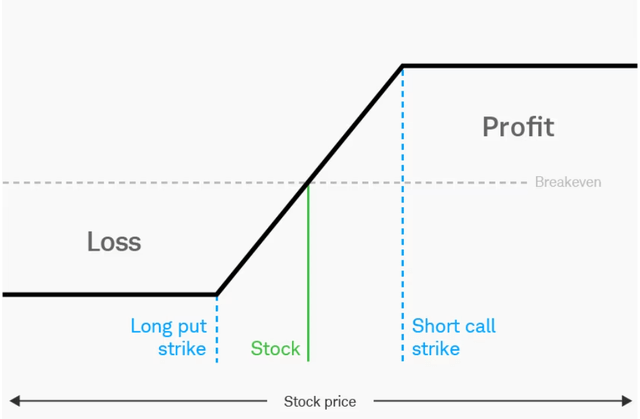
So what’s wrong with this? While protective puts can act as an insurance policy and protect you from very rare black swan events, the premium you are paying for it can be very steep. Protective puts 7-10% below the current price and can still cost as much as 1% per month which is 12% annualized. Most covered call funds underperform the market because they limit their upside in exchange for option premiums even without having any protective puts. For example, S&P 500 index (SPY) is up 426% since 2010 while CBOE S&P 500 Buy Write Index (CBOE) is up only 125% during this time including option premiums received.
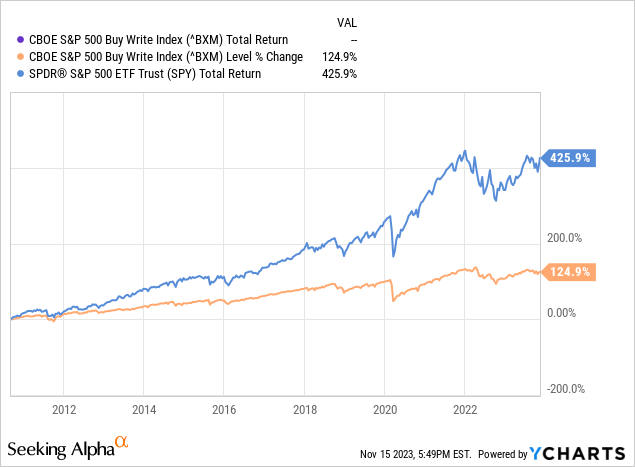
If covered calls underperform the market as it is, then what’s the point of hindering their returns even further by spending a portion of those returns on protective put options? It’s like handicapping a runner who is already behind in a race as it is by giving him a heavy backpack to carry. When NUSI was using a collar strategy religiously, it was underperforming significantly. The fund even underperformed during the bear market of 2022 when it was supposed to shine and outperform due to having protective puts. During the year NUSI was down -28% while S&P 500 was only down -18%. This is because most of NUSI’s protective puts were about 7-10% below the current price and the fund kept rolling them down every month while the market was dropping in slow motion where it would fall 2-3% per month so those protective put options didn’t get triggered and cost the fund extra money, hurting it in the process.

Earlier this year, the fund stopped doing collars in a religious manner. There are times when the fund even stopped writing covered calls at all. Currently, when I look at the fund’s current holdings, the only option contract I see is a put option for 11/23 at the 13,300 level which lost most of its value since the Nasdaq recently had a rally. I am not seeing any covered call plays. Of course, this is subject to change at any time since the fund is actively managed.
NUSI Holdings – partial (Nationwide)
Having no covered calls allowed the fund to rally alongside with Nasdaq in recent weeks and easily outperform the CBOE S&P 500 Collar Index. It pretty much participated in all of Nasdaq’s rally in the last 2 weeks since it held Nasdaq stocks and having protective put options only held it back by less than 1%.
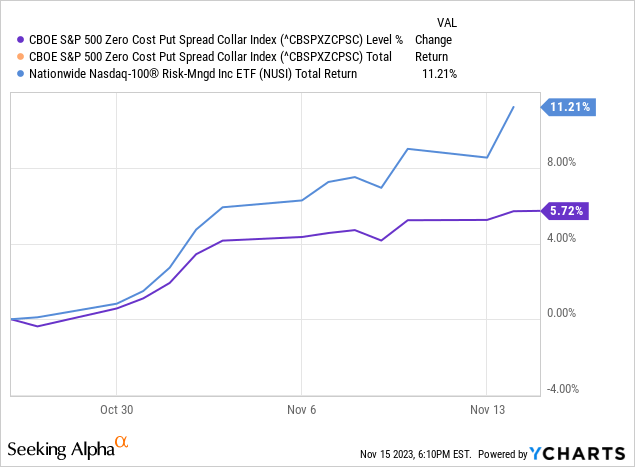
As a result of not having a covered call in place, the fund’s dividend yield took a hit. Originally the fund was supporting a dividend distribution yield of almost 10% supported by its covered calls but now it only pays about 6.6%. When the fund is not engaged in writing covered calls, dividend distributions have to come from somewhere so it will share some shares and book capital gains in order to make distributions. In the long term the fund still targets a dividend yield of 8% so it will probably get there one way or another by applying a mix of covered calls, return of capital, capital gains…etc.
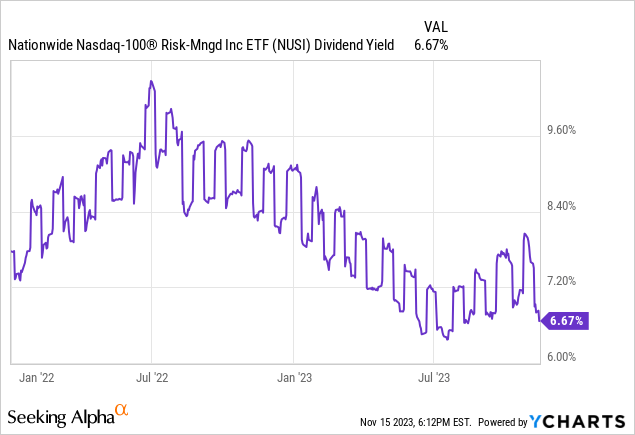
You might be wondering how the fund did from mid-July to late October when Nasdaq was down -10%. Well it turns out that the fund dropped almost as much as Nasdaq did so the put options didn’t offer much protection. Those put options would only offer a meaningful protection in the event of a black swan event where Nasdaq drops more than 10-15% in a matter of weeks but it won’t help much in slower drops.
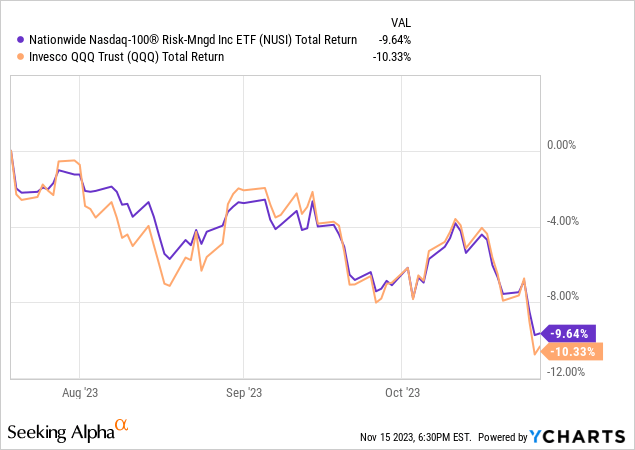
The fund was originally created shortly before the 2020 COVID crash which caused investors to panic about the market dropping as much as -35% in a few short weeks with multiple circuit breakers and limit-downs along the way. The goal of this fund in 2020 was to take advantage of a high-VIX environment to generate income by selling covered calls while also protecting against COVID-like events where the market can crash 25-30% in a matter of weeks. The problem is that those crashes are extremely rare and you are paying a pretty big insurance premium against an event that’s super rare. Since its inception 3.5 years ago, NUSI resulted in total returns of 17% while S&P 500 returned 49% during the same time even after suffering the COVID crash in 2020. By mid-March newly launched NUSI was outperforming SPY by as much as 30% but it didn’t last long as SPY launched a V-shaped recovery followed by a large multi-year rally.
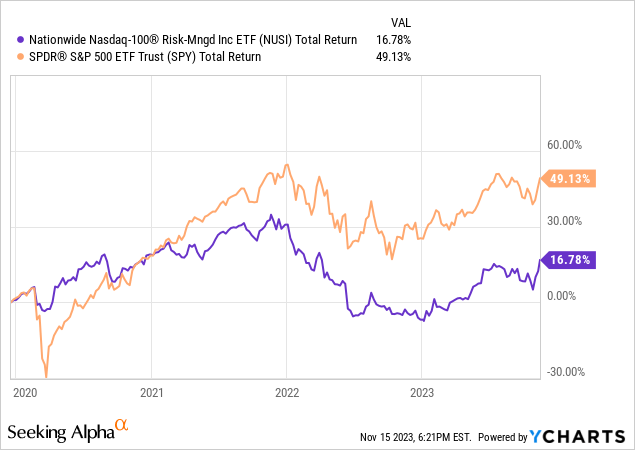
NUSI’s change of strategy is a positive thing because the fund’s original strategy wasn’t working. This new strategy is more likely to deliver good results as compared to the last strategy but jury is still out. Without having covered calls, this could be just QQQ paired with put options and its performance could match QQQ’s performance for the most part. Time will tell if the fund will further change its strategy which could change its performance. I’m still not buying NUSI but I am not as negative on the fund as I was earlier as long as its new strategy sticks.
Read the full article here












